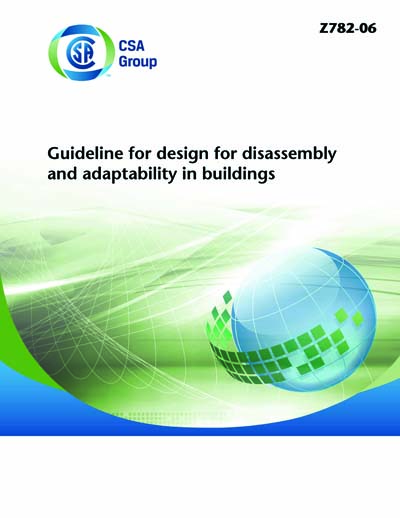Most recent
CSA Z782-2006
Z782-06 - Guideline for Design for Disassembly and Adaptability in Buildings
Intended Use
CSA Z782-06 Guideline for design for disassembly and adaptability in buildings is a voluntary guidance document that provides a framework for reducing building construction waste at the design phase, through specific principles.
Design for disassembly and adaptability (DfD/A) is an approach to sustainability that can reduce the environmental footprint of the building industry by reducing waste generation, improving building longevity, and reducing energy consumption by intelligent design.
The disassembly component of DfD/A seeks to addresses this principle by making it easier to take products and assemblies apart in order to reuse or recycle materials.
The adaptability component of DfD/A focuses on enabling the building to continue to be used beyond its original intent by readily accommodating substantial change within an existing physical asset.
CSA Z782-06 includes a conceptual framework for DfD/A, specific principles and annexes. The Guideline also reviews quantifiable metrics for each DfD/A principle that, after further development, can be assembled into a matrix or checklist to guide users in the direction of disassembly criteria design.
Preface
This is the first edition of CSA Z782, Guideline for design for disassembly and adaptability in buildings. This Guideline provides a framework for reducing building construction waste through design for disassembly and adaptability (DfD/A) principles.1. Scope
1.1 This Guideline addresses the reduction of adverse economic, environmental, and social impacts of building construction through the application of principles related to design for disassembly and adaptability (DfD/A). DfD/A can be used to identify design approaches and potential waste-reduction solutions, to develop system-specific disassembly- and adaptability-conscious details, and to adopt specific strategies for building structure or parts thereof (e.g., the envelope). It applies only to buildings (which can be of any type, including commercial, industrial, institutional, and residential).1.2 The objective of this Guideline is to provide an overview of DfD/A principles and a method of defining the scope of integrating these principles into the design process to reduce the overall environmental burden associated with material assemblies. The disassembly principles can be used to maximize the proportion of building materials that are diverted away from the landfill and reused or recycled toward a better resource life cycle. The adaptability principles can be used to make buildings able to accommodate a larger variety of uses and experience a longer life cycle, reducing the need for additional buildings. From a broader perspective, the reuse of building materials and components from disassembled structures will help move the building industry away from a linear system and toward a circular system, with end-of-life materials reprocessed and used as inputs into new buildings.
1.3 This Guideline also reviews quantifiable metrics for each DfD/A principle that can be assembled into a matrix or checklist to guide users in the direction of disassembly criteria design, though in some situations other tools will be required to perform more detailed analyses. Note: This is the subject of future work.
This Guideline gives the designer an understanding of the environmental factors that can be modified to improve performance throughout the building life cycle. It can be used for new construction and renovations and in the design of incremental improvements in, or wholesale redesign of, building systems.
1.4 This Guideline can be used by architects, planners, and owners of buildings to increase their understanding of their options, and by other parties who are responsible for designing, constructing, or demolishing buildings. Other professionals, e.g., structural, electrical, and mechanical engineers, should also be included in the design team, to ensure all synergies, trade-offs, and other design considerations are covered. This Guideline's principles are applicable to all types of buildings, including commercial, industrial, institutional, and residential structures.
1.5 This Guideline is a guidance document and is not intended to be used for certification or registration purposes.
Content Provider
CSA America, Inc. [csa]






